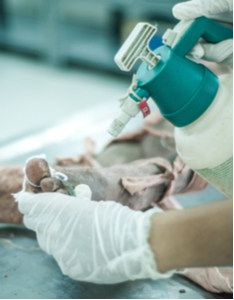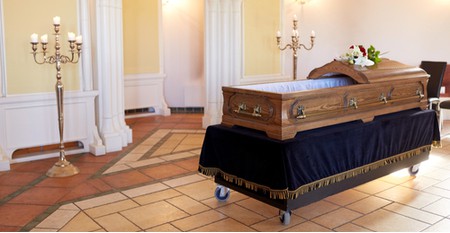If the body of the deceased has not been embalmed, an open casket funeral must be held one to three days after death.
If the body is embalmed, it’s typically recommended to have the funeral within one or two weeks. However, there are also techniques that can preserve the body for a month or more.
When a person dies, decomposition of the body begins right away. As decomposition occurs, the shape, color, and texture of the body can change. Therefore, if a body decomposes too far, an open casket funeral is not possible.
The main factor that determines when an open casket funeral can be held is whether or not the body has been embalmed. Embalming is a process in which chemicals are injected into the arteries, tissues, and organs of a body to forestall decomposition.
Open Casket without Embalming
If a body has not been embalmed, decomposition will begin right away. If the body is stored with proper refrigeration and care at a funeral home, it can be shown at an open casket funeral for approximately two to three days after death.
However, most funeral homes recommend having the open-casket funeral within 24-hours of death to ensure the body is presentable for viewing.
Though embalming is performed on most bodies that are buried in the United States, some people choose to skip the embalming process. The most common reasons for leaving a body un-embalmed include:
- Religious Beliefs:
Some religions, such as the Muslim, Bahá’í, and Orthodox Jewish faiths, prohibit embalming.
- Cremation:
If the body is to be cremated after the open casket funeral, some people opt to forgo the embalming to decrease the funeral costs. However, this practice is only practical if the funeral is held one to three days after death.
- Environmental Impact:
Though embalming has become noticeably less toxic throughout the years, the formaldehyde-based embalming solution is still known to be carcinogenic and have detrimental impacts on the environment.
For green burials, embalming is typically not allowed.
Open Casket with Embalming
In the United States, most bodies presented during open casket funerals have been embalmed. Embalming is a popular choice for open-casket funerals because it delays decomposition, thereby extending the window in which the funeral can be held.
For typical embalming practices, it is recommended that the funeral be held within one-two weeks of the death. Though embalming can last up to a month, the longer one waits, the higher the chances that decomposition will make a viewing impossible.
Unfortunately, embalming is not an exact science. While morticians can predict how long a body will be presentable for viewing following embalming, there are always variables that can alter the overall timeline. Several factors that play a role in how long embalming is able to forestall the body’s degradation include:
- The success of the embalming.
As discussed below, embalming involves a chemical solution being inserted into the arteries, tissues, and organs of a body. If the fluid does not reach certain parts of the body, or the bodily fluids are not completely drained, the areas of the body without embalming fluid will deteriorate at a normal rate.
The chemical composition of the embalming fluid can also affect how effective the embalming process is. If an incorrect composition is used, it can be detrimental to the integrity of the body.
As such, in rare instances, an unsuccessful embalming can ruin the chances of an open casket ceremony.
- The cause of death.
If the deceased died from deteriorating health or trauma, embalming may be more difficult.
Embalming cannot undo any deterioration or trauma that has already occurred; as such, if the body began to deteriorate prior to death, then embalming will not be able to delay decomposition as long.
- The use of refrigeration.

For funerals that are held more than two weeks after death, it is recommended to use a funeral home that also has refrigeration options (not all funeral homes have refrigerated storage on site).
Refrigeration can work in tandem with the embalming to further delay decomposition.
In cases where you know that the funeral will be delayed beyond the two week mark, it is important to let the mortician know prior to the embalming so that they can take additional steps to prevent decomposition.
When a funeral is delayed, morticians may be able to perform the following tasks to elongate the possible timeframe for an open casket funeral:
- Focus on applying embalming fluid throughout the body.
If a mortician knows that a funeral will be held immediately, they will typically use less embalming fluid to save on time and costs. They may also spend less time ensuring that the full body has been reached by the embalming fluid, as it is not essential given the timeframe.
However, if they are aware that the body must stay preserved for a longer amount of time, they can focus on ensuring that the entire body has been reached by the embalming fluid.
- Refrigerate the body.
As stated, refrigeration can help slow the natural decomposition of the body. When refrigerating a body for a long period of time, it is important for the mortician to check the body regularly to check for damage to the body from the low temperatures.
- Rehydrate key areas of the body.
Especially if a body has been embalmed and refrigerated for a long amount of time, it is important for the mortician to regularly rehydrate the body’s extremities, including the fingertips, ears, and toes, along with the nape of the neck, cheeks, and forehead.
Rehydration helps keep the body presentable and lifelike for the viewing.
These techniques are used in a myriad of cases, including delayed funerals, open investigations, and medical donations. In fact, bodies utilized for medical donation have been known to last anywhere from six months to two years without noticeable degradation.
If you are planning an open casket funeral, it is always best to discuss your options with your funeral director. In instances where the funeral is delayed, the funeral director can provide you with the likelihood of an open casket funeral, and discuss alternative options if an open casket funeral is not possible.
The Embalming Process

Embalming is a process of temporary body preservation. It is typically used to preserve a body for open casket viewings and funerals, long-distance transportation, and/or for medical and scientific purposes.
Embalming involves draining the body fluids and injecting the arteries, tissues, and organs with chemical solutions. Embalming is usually accompanied by preparing of the body for viewing.
When a mortician embalms a body, they use the following process:
- Step 1
The mortician massages the body to remove any remaining rigor mortis. The mortician will also apply a cream to keep the skin soft and pliable, especially around the face.
- Step 2
The mouth will be wired or sutured shut, and the eyelids and lips will be glued (when needed) to keep them closed.
- Step 3
Any orifices are then plugged to prevent fluids from escaping. This is important for both the embalming process and for the viewing and/or transportation of the body.
- Step 4
The mortician then performs arterial embalming. In arterial embalming, the embalming fluid is injected into an artery while the blood is drained from a nearby vein or from the heart.
The blood that is removed from the body is poured down the drain. Arterial embalming ensures that any arteries and veins within the body are filled with embalming solution instead of blood.
- Step 5
Step 5. The mortician then performs cavity embalming. The mortician uses a trocar (a pointed, metal tube attached to a suction hose) to puncture each organ in the body.
Once the organ is punctured, the bodily fluids and gasses within the organ are removed, and the organ is filled with an embalming fluid known as “cavity fluid.”
- Step 6
Any punctures from the embalming process are closed.
- Step 7
The mortician dresses the body, styles the hair, and adds makeup to give the body a more lifelike appearance. Cosmetology is also used to hide any discoloration or markings from death.

There are no State or Federal laws in the United States that require embalming for burial. However, five states, including California, Idaho, Kansas, Minnesota, and New Jersey, legally require that a body be embalmed to cross state lines by airplane or train.
Embalming is not required for private viewings or home funerals. However, some funeral homes require that a body be embalmed for open casket ceremonies. If you are having an open casket ceremony, talk to the funeral home about their embalming requirements prior to committing.
In the United States, embalmment typically costs $200-700 dollars.
The cost of embalming is dependent on local rates, as well as the size and condition of the body. The cost of the embalming includes the chemicals and labor hours required to perform the embalmment. If you have a tight budget for your funeral, choosing not to embalm can save you a good amount of money.
Open Casket Funerals
According to the Cambridge Dictionary, an open casket funeral is “a funeral at which the coffin is open and people can see the dead person’s body.” As part of an open casket funeral, the casket is usually placed at either the front of the room or in a side viewing area so that the funeral attendees are able to pay their respects.
Open casket funerals can be run in a number of different ways, depending on the preference of the family and the deceased. Some open casket funerals will keep the casket open throughout the service, while others will have the casket open only until the start of the funeral service.
An open casket typically only involves opening the top half of the casket to allow mourners to see the head and upper torso of the deceased.
Open casket funerals are used to help mourners find closure after the death of a loved one. Viewing the deceased can help mourners come to terms with the death and see that their loved one is not suffering or in pain.
For more information about open casket funerals, see the Full Meaning of Open Casket Funerals.
A Brief History of Embalming and the United States
The process of embalming dates back thousands of years to when ancient Egyptians removed the organs and blood from the body as part of their mummification process.
In the early 1800s, Europeans began to experiment with arterial embalming to preserve the bodies used in anatomical studies.
When the United States was founded, embalming was not a known practice. When you died, you would be interred without any preservative chemicals or cosmetics. While some people would be buried in a cemetery with a headstone, many others were buried at home without the pomp and circumstance we associate with funerals today.

When the Civil War broke out, many families wanted to have the bodies of their loved ones returned from the battlefield. However, given the lack of refrigeration at the time, the bodies would decompose long before they reached their destination.
Opportunistic individuals, upon learning of the embalming process in Europe, began performing “field embalmings” on fallen soldiers. The first American embalmers used a variety of chemicals, including arsenic, creosote, mercury, turpentine, and alcohol. Due to the unregulated nature of these embalmings, the results were often unpredictable, and the process could be dangerous.
Opportunistic field embalmers became so prevalent that in March 1865, the War Department issued an order requiring “all who embalm or remove bodies of deceased officers or soldiers to obtain a special license.
Though embalming was prevalent on the battlefield, it was not incorporated into normal funeral practices until the death of Abraham Lincoln. When Lincoln was assassinated, his body was embalmed; one of the first to be embalmed outside of the war.
Lincoln’s embalmed body was transported in an open casket “funeral train” to its final resting place in Illinois. For nearly three weeks, Americans lined up for a glimpse of their former President’s body on its journey.

For most Americans, this was the first time they had seen an embalmed body. No one had previously seen a corpse with lifelike color and peaceful features. Lincoln’s embalming had a lasting impression on many Americans, and it set the practice of embalming in motion.
Today, the United States and Canada are the only countries where embalming is considered a routine practice. However, as the popularity of green burials and cremations continues to rise, it is possible that embalming will begin to become a thing of the past.

Sources:
https://www.joincake.com/blog/what-is-embalming/
https://beyondthedash.com/blog/funeral-planning/how-long-can-you-delay-a-funeral/6112

